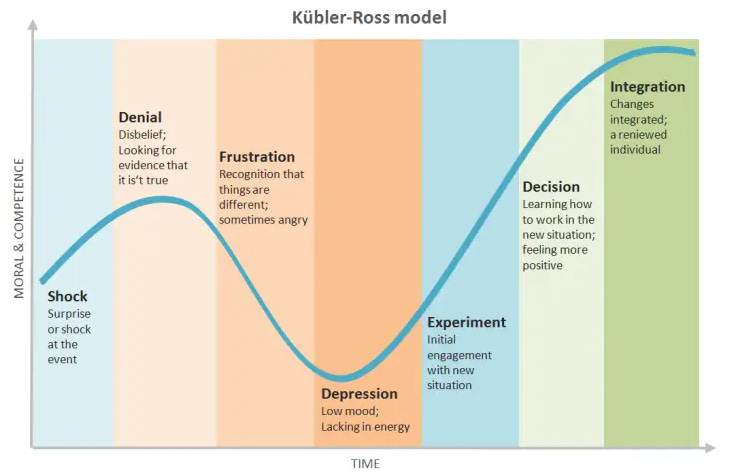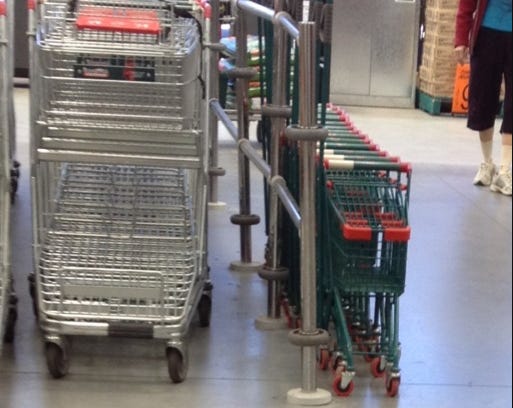Change Management - Lessons from my Toddlers
Heraclitus of Ephesus may never have uttered (some variant of) the words: "The only constant is change", but he did say "you could not step twice into the same river", so I bet he would have approved despite the misattribution.
I doubt anyone would challenge the claim that the rate of social, environmental and technological change is accelerating as we rapidly leave the 20th century behind. Change management, especially in large organisations, is hard.
An internet search for "change management models" will spit out several options, but the one I am most familiar with is the Kübler-Ross Change Curve. Like many change management models and processes from the 1960s, the Kübler-Ross Change Curve is based in grief studies (the "Five Stages of Grief" specifically).
Image Credit: cleverism.com (article linked to above)
Your job as a leader is to support employees through each of the stages. The goals are (1) flattening the curve, i.e. decreasing the impact of the frustration and depression on morale and (2) increasing the gradient, i.e. accelerating the transition from the first stage (shock) to the final stage (integration). Of course, real life is messy, and individuals will move through the curve at their own rate, often doubling back on stages or even experiencing multiple stages simultaneously. However, it is easier to think and reason about the model when change adoption is considered linearly.
You might find it hard to believe, but my two toddlers are nothing like professional adults. However, as a simplified proxy to the complexities of change at an organisational level, they present numerous opportunities to practice. Toddlers like routine and the stability it brings, relatively easily maintained during the week but havoc on the weekends when things need to get done. In other words, I find myself supporting the five stages of grief approximately four times an hour every Saturday.
A typical scenario goes something like this: (1) Me, initiating trip to home improvement store: "Come, my boys, we have to go to Bunnings1." Shock - change happens, they were deeply engrossed in their breakfast session of Bluey. (2) Eldest: "Noooooo, you don't have to go to Bunnings. You have all the things in the garage." (actual quote, he has opinions) Denial - we don't want Bluey to end. We reject your reality and substitute it with our own! (3) I insist: "Get your shoes, mate, we have to go." Frustration and depression (aka tantrums) as I proceed to wrestle them from couch, through shoe-finding and dressing, to car seat, to Bunnings. (4) Arrive at Bunnings, still wrestling until we get to the trolley section. Point them at toddler trolleys2: "Want to get a trolley?" Experiment, Decision, and Integration in rapid succession. Bunnings is the best! (Worth noting is that the same trip requires repeating the process in reverse: "OK boys, time to go home" and there we go again).
So here's what my toddlers have taught me with regards to supporting change:
Shock and Denial: Communication through these phases is vital. When possible, give a heads' up that change is coming, repeat as often as reasonably practicable. Explain the "why". "When this episode finishes, we're going to Bunnings." or "Bluey, teeth, then Bunnings because the light broke and I need to buy a new one, OK?"
Frustration and Depression: Listen with empathy, but stay the course. Repeat the 'why" as necessary. At this point, any indication that the status quo stands a chance of being maintained is a death blow to the initiative. The situation deteriorates, and they'll dig in their heels. I can still bulldoze through it with my boys, albeit at the cost of an extremely unpleasant experience for all. However, you run the risk that your team or even your organisation could descend into crisis in a professional environment. "I can see that you wanted to watch more Bluey, but the lightbulb broke, and I need to buy a new one, or we won't be able to see when it gets dark."
Experiment, Decision and Integration: Support experimentation with training. As soon as you have someone entering the experimentation phase, recruit the person to help you help others with the transition to the final stages of acceptance and commitment. "Careful where you run. There are other people here" and "If you hold the trolley like this, you can push it easier. Can you show your brother how to do it too?"
Finally, celebrating and revisiting successful change adoption, emphasising the cases where the outcome was beneficial and better than expected, helps with future change. "Remember when you were unsure about going to Bunnings, but you did it anyway, and it turned out to be a lot of fun?"
Change management is complex. Reflection and awareness, paying attention to how your staff is experiencing the change, is your best chance at success. As the change initiator, you have likely refined your reasoning for weeks, if not months, leading to your decision. For you, it is no longer a big deal because you've had time to digest every nuance of the reason for the change.
Be sure to communicate the reasoning clearly and accept that your teams will require similar amounts of time to what you had invested in working through the reasoning for themselves.
Until next time.
Psssst! If a friend sent you this newsletter or you found it through social media, consider subscribing (you can unsubscribe any time) and sharing it with your friends and family! You can also find me on Twitter @frontleftwill.
Notes:
For those not in the know, Bunnings is an Australian hardware/DIY supply chain where you spend way too much time and money if you are personally responsible for the upkeep and maintenance of pretty much anything.
Bunnings kiddie trolleys:



